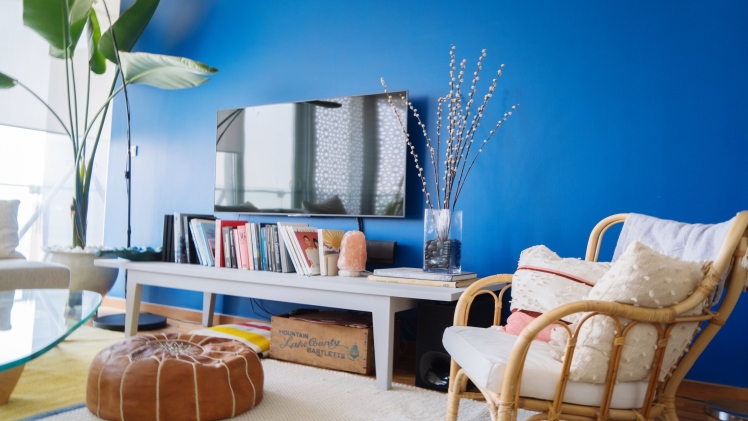Color has the incredible ability to influence our emotions, set the mood, and even alter the perception of space in our homes. When it comes to home decoration, choosing the right color palette is a crucial step in creating the atmosphere you desire. Whether you’re looking to create a serene oasis, a cozy retreat, or a vibrant, energetic space, the power of color can work wonders. In this article, we’ll explore how you can use color to transform your home and create a living environment that suits your personality and lifestyle.
The Psychology of Color
Before we delve into the art of using color to transform your home, it’s important to understand the psychology of color and the emotions it can evoke:
- Warm Colors: Colors like red, orange, and yellow are associated with warmth, energy, and excitement. They can make a space feel cozier and more inviting. Warm colors are great for areas where social interaction and activity are encouraged, such as living rooms and dining rooms.
- Cool Colors: Blues, greens, and purples are considered cool colors. They evoke feelings of calm, relaxation, and serenity. Cool colors work well in bedrooms, bathrooms, and other spaces where you want to create a peaceful atmosphere.
- Neutral Colors: Neutral colors like white, gray, and beige are versatile and timeless. They create a sense of balance and can serve as a backdrop for bolder accent colors. Neutrals are often used in living areas and kitchens.
- Earth Tones: Earthy colors like browns, tans, and greens are reminiscent of nature. They can establish a connection with the outdoors and create a warm, grounded feeling. Earth tones are suitable for any room, especially those that feature natural materials and textures.
- Bright Colors: Vivid, bright colors such as magenta, turquoise, and lime green are energetic and attention-grabbing. They can be used as accents to add a pop of color or to create a sense of playfulness in spaces like children’s rooms and home offices.
Choosing the Right Color Scheme
Selecting the right color scheme for your home can be a daunting task, but it’s a crucial step in the transformation process. Here are some guidelines to help you make informed decisions:
- Consider Room Function: Start by thinking about the function of each room. What emotions or moods do you want to evoke in those spaces? For example, you might want a serene and peaceful bedroom, an energetic and social living room, or a productive and focused home office.
- Create a Cohesive Flow: While each room can have its unique color scheme, it’s essential to maintain a sense of continuity throughout your home. Use a common color or design element to link different spaces, like a shared accent color or a consistent flooring choice.
- Natural Light: The amount of natural light a room receives can significantly affect how colors appear. Consider the orientation and size of the windows when choosing colors. Darker rooms may benefit from lighter colors to maximize the available light, while rooms flooded with sunlight can handle deeper shades.
- Personal Preferences: Your personal preferences should be at the forefront of your color decisions. Think about colors that make you feel happy, relaxed, or inspired. Your home is a reflection of your personality, so don’t be afraid to incorporate your favorite hues.
- Test Samples: It’s always a good idea to test paint samples on your walls before committing to a color. This allows you to see how the color looks in your specific lighting and how it interacts with your existing furnishings.
Transforming Specific Rooms
Each room in your home serves a unique purpose, and the colors you choose should support and enhance that purpose. Here’s a room-by-room guide on how to use color to transform these spaces:
- Living Room:
- Color Scheme: Consider warm, inviting colors like earthy tones, rich reds, and cozy oranges. Incorporate neutral hues as a base and add pops of color through accessories and artwork.
- Furniture: Choose upholstery and furniture that complements your color scheme. Incorporate comfortable seating, and don’t be afraid to mix and match textures.
- Accessories: Add colorful throw pillows, blankets, and artwork to infuse personality and flexibility. Experiment with different patterns and textures.
- Dining Room:
- Color Scheme: Opt for rich, deep colors like burgundy, navy, or forest green to create a sense of sophistication. Warm wood tones on furniture and floors can balance the intensity of the wall colors.
- Furniture: Invest in a beautiful dining table and chairs that match the room’s aesthetic. Consider a statement chandelier for added impact.
- Accessories: Enhance the dining experience with fine tableware, linens, and centerpieces that harmonize with the room’s color palette.
- Kitchen:
- Color Scheme: Kitchens benefit from a balance of light and bright colors. Choose neutral cabinetry and countertops, but add pops of color with colorful backsplashes, colorful dishware, and kitchen textiles.
- Furniture: Kitchen islands and stools can be a great way to introduce color and contrast. Consider bar stools in a bold hue or even a colorful appliance.
- Accessories: Decorate with colorful kitchen gadgets, utensils, and vibrant plants. These small additions can make a big impact.
- Bedroom:
- Color Scheme: Create a tranquil and restful atmosphere with cool and soothing colors like soft blues, gentle greens, and muted purples. Avoid using overly stimulating shades.
- Furniture: Choose bedroom furniture in neutral tones to maintain a calming ambiance. Upholstered headboards in a complementary color can add a touch of luxury.
- Accessories: Soften the room with plush bedding, throw pillows, and draperies that match the color scheme. Personalize the space with artwork that resonates with you.
- Bathroom:
- Color Scheme: Bathrooms can benefit from a spa-like feel, so opt for cool, calming colors like pale blues, soft greens, or serene grays. Consider using tiles in various shades.
- Furniture: Select vanities, storage, and fixtures that complement your color palette. Matte black or brushed gold finishes can add a touch of sophistication.
- Accessories: Incorporate towels, shower curtains, and bath mats in coordinating colors. Bring in natural elements like plants to create a sense of serenity.
- Home Office:
- Color Scheme: A home office should encourage focus and productivity. Opt for colors like soft greens or blues, or neutral grays and beiges. These shades promote concentration and creativity.
- Furniture: Choose functional and ergonomic office furniture in colors that blend with your color scheme. Keep the space uncluttered for optimal efficiency.
- Accessories: Organize your office with colorful storage solutions. Decorate with artwork and décor that inspires you and contributes to your work.
- Children’s Room:
- Color Scheme: Children’s rooms offer an opportunity for creativity and fun. Experiment with playful, vibrant colors, or choose soft pastels for a soothing environment.
- Furniture: Invest in furniture that grows with your child, such as convertible cribs or adjustable shelving. Consider colorful and whimsical designs.
- Accessories: Decorate with vibrant bedding, rugs, and wall decals. Encourage your child’s creativity by involving them in the design process.
- Home Theater:
- Color Scheme: Home theaters should create a cinematic atmosphere. Use dark, rich colors like deep charcoal, navy, or burgundy to enhance the immersive experience.
- Furniture: Select comfortable, theater-style seating with cupholders and storage. Dark leather or fabric upholstery complements the room’s ambiance.
- Accessories: Enhance the experience with blackout curtains, surround sound, and a large screen. Decorate with movie posters and framed memorabilia.
Incorporating Color Trends
Color trends can provide fresh inspiration for your home’s transformation. Keep an eye on color forecasts from industry experts, such as Pantone and Sherwin-Williams, to stay up-to-date with the latest color trends. Here are some ways to incorporate trending colors:
- Accent Walls: If you’re hesitant to fully commit to a trendy color, consider using it for an accent wall. This allows you to experiment with the hue without overwhelming the entire space.
- Furniture and Decor: Introduce trendy colors through furniture and décor items. This is an easy way to stay on-trend while maintaining the flexibility to update or replace items as trends change.
- Accessories: Use accessories like throw pillows, vases, artwork, and rugs to bring in trendy colors. These elements can be easily swapped out as new trends emerge.
- Textiles: Trendy colors can be incorporated through textiles like curtains, bedding, and table linens. Textiles allow you to infuse a space with color while maintaining versatility.
- Paint: For those who are bold and confident in their choice, consider painting an entire room in a trendy color. This can be a transformative move that completely refreshes your space.
Conclusion
Color is a powerful tool that can completely transform your home, turning it into a space that reflects your personality, meets your functional needs, and evokes the desired emotions. By understanding the psychology of color and carefully selecting the right color schemes for different rooms, you can create an environment that aligns with your vision. Whether you’re aiming for a serene bedroom, a lively living room, or a productive home office, color plays a crucial role in achieving your design goals. Be sure to explore current color trends to stay inspired and up-to-date, and remember that your home is your canvas for self-expression. So, embrace the power of color and embark on a journey to transform your living spaces into places of beauty and comfort.

